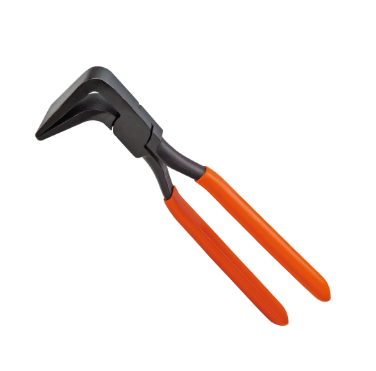Understanding Tin Metal Snips and Their Uses
What Are Tin Metal Snips?
Tin metal snips, also known simply as tin snips or AVIATION SNIPS, are essential hand tools specifically designed for cutting metal sheets with precision. They feature sharp, often curved blades that allow for clean and accurate cuts, making them ideal for various metalworking tasks. These tools come in numerous designs to cater to different cutting needs, making them versatile enough to handle materials like aluminum, brass, and stainless steel. The adaptability and efficacy of tin metal snips make them indispensable in both DIY and professional settings for precise sheet metal cutting.
Common Applications in DIY and Professional Settings
In both DIY and professional contexts, tin metal snips find wide application due to their versatility and ease of use. In the construction industry, they are pivotal for tasks like roofing, guttering, and ductwork installations—where precise metal shaping is necessary. For DIY enthusiasts, tin snips are invaluable tools for crafts and home improvement projects thanks to their ability to execute efficient cuts without the need for powered cutting equipment. Whether for installing metal panels or creating intricate metal artworks, tin snips prove to be an incredibly handy asset.
Types of Tin Snips for Different Cutting Needs
Straight-Cut Tin Snips
Straight-cut tin snips are tailored for precision when making long, straight cuts in metal sheets. These snips are essential for projects requiring clean, linear cuts, ensuring every cut is accurate and aligns perfectly with project requirements. They are ideal for large-scale projects where precision is crucial, such as constructing straight sections in ductwork or any task requiring sharp angles. If you frequently execute such tasks, investing in a quality straight-cut tin snip could immensely enhance your workflow.
Left-Cut and Right-Cut Tin Snips
Specifically designed to tackle curves and intricate shapes in metal, left-cut and right-cut tin snips are invaluable in sheet metal work. These snips allow artisans and builders to navigate corners and create detailed designs with ease and precision, making them particularly useful for projects that require a lot of curvature, like custom metal signage or decorative elements. The unique blade design enables smooth, controlled cuts, essential for nuanced details in sheet metal.
Aviation Snips vs. Traditional Tin Snips
Aviation snips are a modern twist on the traditional tin snip, offering improved leverage and control for intricate cuts. While traditional tin snips handle basic tasks adeptly, aviation snips excel in heavy-duty applications, often becoming the tool of choice for professionals who need enhanced cutting efficiency and less physical strain. Their robust design and ergonomic handles make them suitable for extended use, making complex cutting tasks more manageable and precise.
Key Features to Look for in Quality Tin Snips
Blade Material and Durability
When selecting high-quality tin snips, it's essential to consider the blade material. Blades made from tough steel alloys offer significant longevity and resistance to wear. These materials ensure that the tools can withstand regular use without losing their sharpness or effectiveness. Additionally, features like heat treatment and chrome plating can significantly enhance the performance and durability of tin snips, providing an added layer of protection against corrosion and wear.
Ergonomic Handle Design
A crucial feature in any tin snips is the ergonomic handle design, which plays a vital role in reducing user fatigue and improving grip during extended use. Look for handles that are cushioned or rubberized, as this design provides comfort and reduces the risk of slipping. A well-designed handle ensures a firm grip, minimizing strain on the wrists and hands, especially useful for prolonged cutting tasks.
Cutting Capacity and Gauge Thickness
Understanding the cutting capacity and gauge thickness of tin snips is indispensable when aiming to fulfill your specific cutting needs. The cutting capacity indicates the maximum thickness of metal each model can handle. Tin snips are available in different models that cater to various gauge thicknesses, making it crucial to choose one that aligns with your requirements, whether for light or heavy-duty work. Evaluating this feature ensures efficiency and flexibility in handling diverse metal cutting tasks.
How to Choose the Right Tin Snips for Your Project
Assessing Your Project Requirements
To select the perfect tin snips for your needs, it's vital to assess the specific requirements of your project. Consider the type of metal you'll be working with and the complexity of cuts needed. For instance, if your project involves making straight cuts, a pair of straight tin snips would be ideal. However, for cutting curves, left-cut or right-cut snips may be more appropriate. Understanding these requirements will guide your choice, ensuring the tools you select will handle the job efficiently and effectively. This analysis is crucial in determining which snips will best serve your project's demands.
Balancing Budget and Performance
While choosing tin snips, balancing your budget with the desired level of performance is key. Although cheaper tin snips might seem appealing, they often lead to poor performance and potential safety issues over time. Investing in a quality pair ensures reliability, better functionality, and increased durability, which ultimately pays off in the long run. Quality tools not only improve cutting efficiency but also reduce the likelihood of tool failure, making them a worthwhile investment for both DIY enthusiasts and professionals alike. By opting for a reliable brand within your budget, you secure better results and maximize tool longevity.
Maintenance Tips for Long-Lasting Tin Snips
Cleaning and Lubrication Best Practices
Maintaining the efficiency and longevity of tin snips starts with regular cleaning and lubrication. This crucial routine helps preserve the sharpness of the blades and prevents the onset of rust, which can degrade performance over time. I recommend using a soft cloth to carefully wipe down the blades after each use to remove any debris or moisture. Once the blades are clean, applying a suitable lubricant like machine oil can ensure smooth operation and protect against friction and wear. This simple maintenance practice significantly contributes to the tool's lifespan.
Proper Storage to Prevent Damage
Proper storage plays a vital role in extending the lifespan of tin snips. By keeping them in a dry, moisture-free environment, you can effectively prevent corrosion, which is a common issue with metal tools. I find using a protective case or a magnetic strip particularly helpful for not only organizing the snips but also for providing an added layer of security. Storing them this way ensures that the blades are less likely to be damaged or dulled by unintended contact with other tools or surfaces, maintaining their cutting precision for future projects.
FAQ Section
What materials can tin snips cut?
Tin snips can cut through various materials, including aluminum, brass, stainless steel, and other metal sheets.
How do I choose the right tin snips for curved cuts?
For curved cuts, you should opt for left-cut or right-cut tin snips, as they are designed to handle curves and intricate shapes efficiently.
What is the advantage of aviation snips over traditional tin snips?
Aviation snips offer improved leverage and control, making them more suitable for heavy-duty applications requiring enhanced cutting efficiency.


